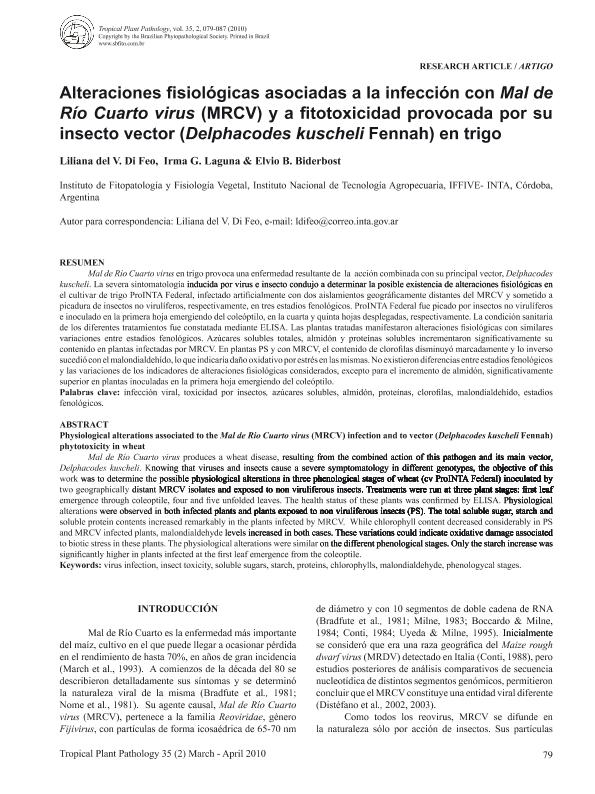Artículo
Mal de Río Cuarto virus en trigo provoca una enfermedad resultante de la acción combinada con su principal vector, Delphacodes kuscheli. La severa sintomatología inducida por virus e insecto condujo a determinar la posible existencia de alteraciones fisiológicas en el cultivar de trigo ProINTA Federal, infectado artificialmente con dos aislamientos geográficamente distantes del MRCV y sometido a picadura de insectos no virulíferos, respectivamente, en tres estadios fenológicos. ProINTA Federal fue picado por insectos no virulíferos e inoculado en la primera hoja emergiendo del coleóptilo, en la cuarta y quinta hojas desplegadas, respectivamente. La condición sanitaria de los diferentes tratamientos fue constatada mediante ELISA. Las plantas tratadas manifestaron alteraciones fisiológicas con similares variaciones entre estadios fenológicos. Azúcares solubles totales, almidón y proteínas solubles incrementaron significativamente su contenido en plantas infectadas por MRCV. En plantas PS y con MRCV, el contenido de clorofilas disminuyó marcadamente y lo inverso sucedió con el malondialdehído, lo que indicaría daño oxidativo por estrés en las mismas. No existieron diferencias entre estadios fenológicos y las variaciones de los indicadores de alteraciones fisiológicas considerados, excepto para el incremento de almidón, significativamente superior en plantas inoculadas en la primera hoja emergiendo del coleóptilo. Mal de Río Cuarto virus produces a wheat disease, resulting from the combined action of this pathogen and its main vector, Delphacodes kuscheli. Knowing that viruses and insects cause a severe symptomatology in different genotypes, the objective of this work was to determine the possible physiological alterations in three phenological stages of wheat (cv ProINTA Federal) inoculated by two geographically distant MRCV isolate and exposed to non viruliferous insects Treatments were run at three plant stages first leaf emergence through coleoptile, four and five unfolded leaves. The health status of these plants was confirmed by ELISA. Physiological alterations were observed in both infected plants and plants exposed to non viruliferous insects (PS). The total soluble sugar, starch and soluble protein contents increased remarkably in the plants infected by MRCV. While chlorophyll content decreased considerably in PS and MRCV infected plants, malondialdehyde levels increased in both cases. These variations could indicate oxidative damage associated to biotic stress in these plants. The physiological alterations were similar on the different phenological stages. Only the starch increase was significantly higher in plants infected at the first leaf emergence from the coleoptile.
Alteraciones fisiológicas asociadas a la infección con Mal de Río Cuarto virus (MRCV) y a fitotoxicidad provocada por su insecto vector (Delphacodes kuscheli Fennah) en trigo
Título:
Physiological alterations associated to the Mal de Rio Cuarto virus (MRCV) infection and to vector (Delphacodes kuscheli Fennah) phytotoxicity in wheat
Fecha de publicación:
04/2010
Editorial:
Sociedade Brasileira de Fitopatologia
Revista:
Tropical Plant Pathology
ISSN:
1982-5676
e-ISSN:
1983-2052
Idioma:
Español
Tipo de recurso:
Artículo publicado
Clasificación temática:
Resumen
Archivos asociados
Licencia
Identificadores
Colecciones
Articulos(CCT - CORDOBA)
Articulos de CTRO.CIENTIFICO TECNOL.CONICET - CORDOBA
Articulos de CTRO.CIENTIFICO TECNOL.CONICET - CORDOBA
Citación
Di Feo, Liliana del Valle; Laguna, Irma Graciela; Biderbost, Elvio B.; Alteraciones fisiológicas asociadas a la infección con Mal de Río Cuarto virus (MRCV) y a fitotoxicidad provocada por su insecto vector (Delphacodes kuscheli Fennah) en trigo; Sociedade Brasileira de Fitopatologia; Tropical Plant Pathology; 35; 2; 4-2010; 79-87
Compartir
Altmétricas




